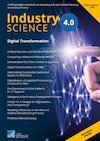Search


Bibtex
Cite as text
@Article{Uhrich+Lange+Carnot+Schäfer,
Cite-key = "Uhrich2023Pre",
Year= "2023",
Number= "1",
Volume= "Industry 4.0 Science 39",
Pages= "88-94",
Journal = "Industry 4.0 Science",
Title= "Predictive Manufacturing – An Intelligent Monitoring System to Detect Anomalies in 3D Printing",
Author= "Benjamin Uhrich, Shirin Lange and Miriam Louise Carnot, University of Leipzig, Martin Schäfer, SIEMENS AG Berlin",
Doi= "https://doi.org/10.30844/I4SE.23.1.88",
Abstract= "In selective laser melting, metal powder is melted layer by layer and fused with the already manufactured part. Within this process, defective layers are created, which can be avoided. Such defects can only be detected by various compression and tensile strength experiments after printing is complete. This procedure is costly and inefficient. Therefore, a demonstrator is presented that uses machine learning methods to identify defective layers during the manufacturing process. In addition, the machine operator
is supported with decision recommendations.",
Keywords= "intelligent systems, autoencoders, 3D printing, machine learning, decision support, selective laser melting, SLM, Siemens, LAB color model, Contrast Limited Adaptive Histogram Equalization, CLAHE",
}
Benjamin Uhrich, Shirin Lange and Miriam Louise Carnot, University of Leipzig, Martin Schäfer, SIEMENS AG Berlin(2023): Predictive Manufacturing – An Intelligent Monitoring System to Detect Anomalies in 3D Printing. Industry 4.0 Science 391(2023), S. 88-94. Online: https://doi.org/10.30844/I4SE.23.1.88 (Abgerufen 21.12.25)
Open Access
Abstract
Abstract
In selective laser melting, metal powder is melted layer by layer and fused with the already manufactured part. Within this process, defective layers are created, which can be avoided. Such defects can only be detected by various compression and tensile strength experiments after printing is complete. This procedure is costly and inefficient. Therefore, a demonstrator is presented that uses machine learning methods to identify defective layers during the manufacturing process. In addition, the machine operator is supported with decision recommendations.
Keywords
Schlüsselwörter
intelligent systems, autoencoders, 3D printing, machine learning, decision support, selective laser melting, SLM, Siemens, LAB color model, Contrast Limited Adaptive Histogram Equalization, CLAHE

 Deutsch
Deutsch